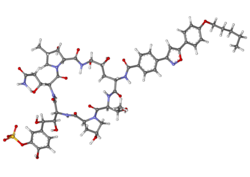Chemistry:Micafungin
 | |
 | |
| Clinical data | |
|---|---|
| Trade names | Mycamine |
| AHFS/Drugs.com | Monograph |
| License data |
|
| Routes of administration | Intravenous |
| ATC code | |
| Legal status | |
| Legal status |
|
| Pharmacokinetic data | |
| Protein binding | 99.8% |
| Metabolism | Via catechol-O-methyltransferase pathway |
| Elimination half-life | 11–17 hours |
| Excretion | 40% feces, <15% urine |
| Identifiers | |
| |
| CAS Number | |
| PubChem CID | |
| DrugBank | |
| ChemSpider | |
| UNII | |
| KEGG | |
| ChEMBL | |
| Chemical and physical data | |
| Formula | C56H71N9O23S |
| Molar mass | 1270.28 g·mol−1 |
| 3D model (JSmol) | |
| |
| |
| | |
Micafungin, sold under the brand name Mycamine, is an echinocandin antifungal medication used to treat and prevent invasive fungal infections including candidemia, abscesses, and esophageal candidiasis. It inhibits the production of beta-1,3-glucan, an essential component of fungal cell walls that is not found in mammals.
Administered intravenously, Micafungin received final approval from the U.S. Food and Drug Administration (FDA) in March 2005, and gained approval in the European Union in April 2008. It is on the World Health Organization's List of Essential Medicines.[1]
In August 2023, Mycamine was acquired from Astellas Pharma by Sandoz.[2]
Indications
Micafungin is indicated for the treatment of candidemia, acute disseminated candidiasis, Candida peritonitis, abscesses and esophageal candidiasis.
Micafungin works by way of concentration-dependent inhibition of 1,3-beta-D-glucan synthase resulting in reduced formation of 1,3-beta-D-glucan, which is an essential polysaccharide comprising one-third of the majority of Candida spp. cell walls. This decreased glucan production leads to osmotic instability and thus cellular lysis. [3] [4]
Dosage
The metabolism of micafungin occurs hepatically via acryp sulfatase followed by secondary metabolism by a transferase. Precautions should be taken with regards to dosing, as micafungin weakly inhibits CYP3A4.[5][6]
Dosage forms
Micafungin is a natural antifungal product derived from other fungi as a defense mechanism for competition of nutrients, etc. To be specific, micafungin is derived from FR901379, and is produced by Coleophoma empetri.[7][8]
References
- ↑ World Health Organization model list of essential medicines: 22nd list (2021). Geneva: World Health Organization. 2021. WHO/MHP/HPS/EML/2021.02.
- ↑ "Sandoz concludes acquisition of Mycamine antifungal agent" (in en-US). 28 August 2023. https://www.pharmaceutical-technology.com/news/sandoz-acquisition-mycamine-antifungal-astellas/.
- ↑ "Micafungin versus caspofungin for treatment of candidemia and other forms of invasive candidiasis". Clinical Infectious Diseases 45 (7): 883–93. October 2007. doi:10.1086/520980. PMID 17806055.
- ↑ "Successful treatment of oesophageal candidiasis by micafungin: a novel systemic antifungal agent". Alimentary Pharmacology & Therapeutics 20 (4): 475–81. August 2004. doi:10.1111/j.1365-2036.2004.02083.x. PMID 15298643.
- ↑ "Micafungin". The Annals of Pharmacotherapy 38 (10): 1707–21. October 2004. doi:10.1345/aph.1D301. PMID 15340133.
- ↑ "A multicenter, open-label clinical study of micafungin (FK463) in the treatment of deep-seated mycosis in Japan". Scandinavian Journal of Infectious Diseases 36 (5): 372–9. 2004. doi:10.1080/00365540410020406. PMID 15287383.
- ↑ "Micafungin: a sulfated echinocandin". The Journal of Antibiotics 62 (1): 27–35. January 2009. doi:10.1038/ja.2008.3. PMID 19132058.
- ↑ "Discovery of micafungin (FK463): A novel antifungal drug derived from a natural product lead". Pure and Applied Chemistry 79 (4): 603–614. 2007. doi:10.1351/pac200779040603.
Further reading
- "Comparison of echinocandin antifungals". Therapeutics and Clinical Risk Management 3 (1): 71–97. March 2007. doi:10.2147/tcrm.2007.3.1.71. PMID 18360617.
 |

